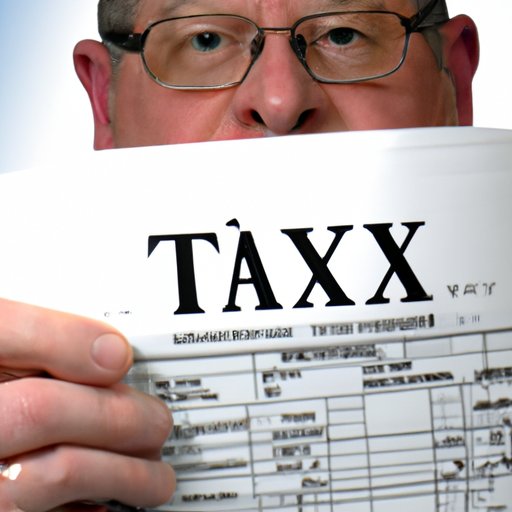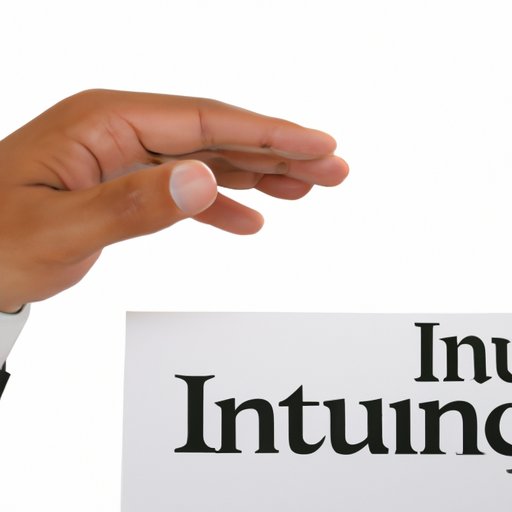Introduction
Having health insurance is essential in order to access quality medical care. It helps protect you and your family from unexpected medical costs and ensures that you can get the care you need when you need it. But if you’re not sure if you have health insurance, it can be daunting trying to figure out where to start. This article will provide a comprehensive guide on how to check if you have health insurance.
Definition of Health Insurance
Before we dive into the steps for checking if you have health insurance, it’s important to understand what health insurance is. According to the Centers for Medicare & Medicaid Services (CMS), health insurance is “a type of insurance coverage that pays for medical and surgical expenses that are incurred by the insured. Health insurance can reimburse the insured for expenses incurred from illness or injury, or pay the care provider directly.” In other words, health insurance is a form of financial protection that helps cover the cost of medical care.
Overview of Problem
If you’re unsure if you have health insurance, it can be difficult to know where to begin. You may be able to get health insurance through your employer, the government, or an individual plan. It’s also possible that you’re already covered under a family member’s policy. So how do you determine if you have health insurance? Here are the steps you should take to check if you have health insurance.
Contact Your Employer
If you’re employed, the first step you should take is to contact your employer to see if they offer health insurance as part of your benefits package. If you don’t know who to contact, start by calling the HR department. According to a study by the Kaiser Family Foundation, “56% of employees receive health insurance through their employers.”
Ask HR Department
When you reach out to the HR department, ask them if health insurance is offered as part of your benefits package. They should be able to provide you with information about the types of plans available and any associated costs. They can also provide you with details about enrollment deadlines and what documents you need to submit in order to sign up for coverage.
Learn About Benefits Package
When speaking to the HR department, make sure to ask questions about the specific benefits offered as part of your package. For example, is there a deductible or copayment associated with the plan? Is there a cap on how much the plan will pay out each year? Are there any restrictions on what type of care is covered? Knowing the answers to these questions can help you determine if the plan is right for you.
Check Your Paystubs
If you’ve been employed for some time, another way to check if you have health insurance is to look at your paystubs. If you’re enrolled in a health insurance plan through your employer, there should be deductions taken out of your paycheck to cover the cost of your premiums. The amount taken out of your paycheck each month should be listed on your paystub.
Look for Deduction Indicators
On your paystub, look for any indicators that suggest you’re paying for health insurance. These could include a line item labeled “health insurance” or “medical insurance,” or a deduction labeled “HSA,” which stands for health savings account. If you see any of these indicators on your paystub, it’s likely that you’re enrolled in a health insurance plan through your employer.
Examine Reimbursement Amounts
Another indicator that you may have health insurance is if you’re receiving reimbursement amounts from your employer for medical expenses. If you’ve had to pay out of pocket for medical care, such as doctor’s visits or prescriptions, you may be eligible for reimbursement from your employer. Look for any reimbursement amounts listed on your paystub to determine if you’re receiving reimbursement for medical expenses.
Review Your Employee Benefits Package
If you’re still unsure if you have health insurance, look at your employee benefits package. This should provide information about the types of coverage you’re eligible for and what’s included in the plan. Make sure to read through the policy details carefully to ensure you understand the coverage you’re receiving and any associated costs.
Identify Types of Coverage
When reviewing your employee benefits package, look for any information about the types of coverage you’re eligible for. This could include preventive care, hospitalization, prescription drug coverage, and mental health services. Make sure to note any limitations or exclusions in the policy so you can plan accordingly.
Read Through Policy Details
The policy details section of your employee benefits package can provide valuable information about your health insurance coverage. This includes information about co-pays and deductibles, as well as any special programs or discounts you may be eligible for. Make sure to read through this section carefully to understand what’s covered and what isn’t.

Look at Your Tax Forms
If you’re still unsure if you have health insurance, look at your tax forms. Depending on your situation, you may be eligible for tax credits or deductions for health insurance premiums. According to the Internal Revenue Service (IRS), “you may be eligible to claim a premium tax credit to help pay for health insurance purchased through the Health Insurance Marketplace.”
Check for Tax Credits
When looking at your tax forms, look for any lines indicating that you’re eligible for a premium tax credit. This means that you’re eligible for a discount on your health insurance premiums. To qualify for the premium tax credit, you must meet certain income requirements, so make sure to read through the eligibility requirements carefully.
Look for Premium Deductions
In addition to looking for tax credits, look for any deductions related to your health insurance premiums. If you’re eligible for a premium deduction, it means that you’re able to deduct a portion of your health insurance premiums from your taxes. Again, make sure to read through the eligibility requirements carefully before claiming any deductions.

Reach Out to Your Insurance Company
If you’ve determined that you’re enrolled in a health insurance plan, the next step is to reach out to your insurance company to confirm your coverage status. Contact your insurance company to get details about the plan, such as what’s covered and what’s not. This will help you understand your coverage and ensure that you’re getting the most out of your plan.
Confirm Coverage Status
When you reach out to your insurance company, make sure to confirm your coverage status. Ask them to provide you with a copy of your current policy and any additional information you might need to understand the coverage you’re receiving. This will help you make sure that you’re getting the most out of your plan.
Get Details About Plan
When speaking to your insurance company, make sure to ask for details about the plan. This includes information about co-pays and deductibles, as well as any special programs or discounts you may be eligible for. Make sure to read through the policy details carefully to ensure you understand the coverage you’re receiving and any associated costs.
Consult Your State’s Health Insurance Marketplace
If you’re still unsure if you have health insurance, you can consult your state’s health insurance marketplace. The health insurance marketplace is an online portal that allows you to compare different plans and determine if you’re eligible for coverage. According to the CMS, “the Marketplace is designed to help people without health coverage learn about their options, compare plans, and enroll in coverage.”
Learn About Eligibility Requirements
When using the health insurance marketplace, make sure to read through the eligibility requirements carefully. This will help you determine if you’re eligible for coverage and what type of plan you qualify for. Additionally, make sure to read through the details of each plan to understand what’s covered and any associated costs.
Compare Different Plans
Once you’ve read through the eligibility requirements and the details of each plan, you can compare different plans to find the one that’s right for you. Make sure to look for plans that meet your needs and fit within your budget. Additionally, make sure to read through the terms and conditions of each plan to understand what’s covered and any associated costs.
Conclusion
Figuring out if you have health insurance can be a daunting task. But by following the steps outlined in this article, you can easily check if you have health insurance. Start by contacting your employer to learn about your benefits package, then review your paystubs and employee benefits package. Additionally, look at your tax forms and consult your state’s health insurance marketplace. Finally, reach out to your insurance company to confirm your coverage status and get details about the plan. Having health insurance is essential in order to access quality medical care, so make sure to take the time to ensure that you’re covered.
(Note: Is this article not meeting your expectations? Do you have knowledge or insights to share? Unlock new opportunities and expand your reach by joining our authors team. Click Registration to join us and share your expertise with our readers.)
